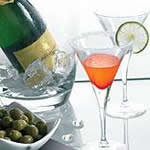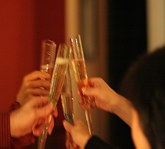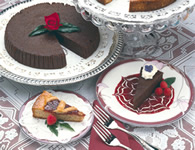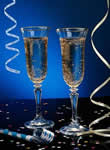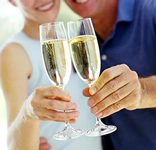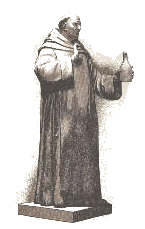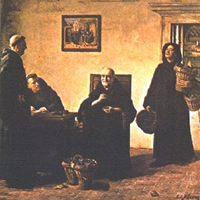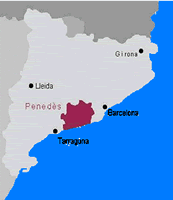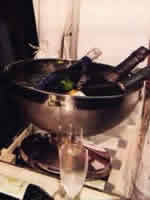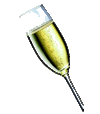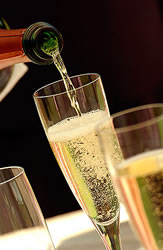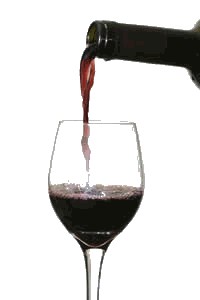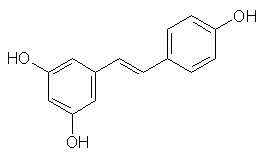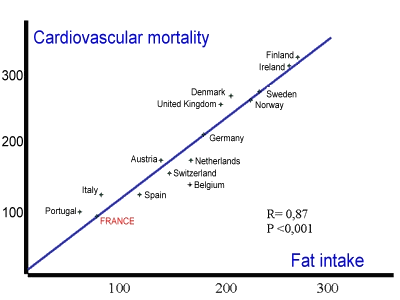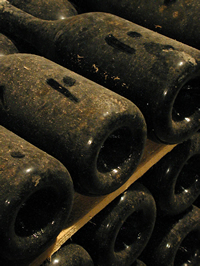We can say that Cava is two times wine, in the sense that a first fermentation of grapes produces the wine, and a second fermentation of that wine produces what we know as Cava.
The tradition attributes the "invention" of the sparkling wine to the famous Benedictine friar Pierre Perignon. In fact, we can't talk of invention since there have always been sparkling wines. Already in century XIV, Francesc Eiximenis, monk from Girona, wrote about wines "saltants i formigalejants" (jumping and fizzing, a graphical description of the bubbles). Many centuries before, Virgilio in the Eneida mentions "spumantem" wines. Both authors describe therefore wines that overflowed the bottle, overflowed the glasses, produced a tickling at the palate and gave a pleasant sensation of coolness in the mouth, but the most important, cheered the heart.
|
|
| |
However, the merit corresponds to Dom Perignon because he studied the phenomenon and improved its technique of preparation by the coupage or wine mixture. It's also his merit to have incorporated two important new features for the conservation of the product: the cork cap and the resistant glass bottle.
But let's know about the legend that adorns the origins of this fascinating drink. It says the legend that certain day of 1670, Dom Pierre Perignon, monk of the Benedictine Abbey of Hautvillers near to Epernay in the zone of the Champagne, was surprised in his daily task by the unexpected outbreak of one of the bottles that rested in the calm of the monastic cellar. Impressed by this strange event he tasted immediately the overflowed liquid, as his experienced taster instinct dictated. His initial surprise turned on delighted joy: he had savoured the "stars wine", as he communicated, joyfully, to the rest of the brothers of the Benedictine community.
|
|
| |
|
The chance had provided to the monk the opportunity to accede to the knowledge of a natural phenomenon whose effects had been looked for on the times in that ignored greeks taverners added honey to wine looking for the sparkling bubbles, whose appearance was anxiously awaited in the beginnings of the spring. The phenomenon was not other that the spontaneous fermentation of the wine (due to the natural sugar of the grape and the existing leavenings in its skin) with the consequent production of carbonic fruit of the consumption of the sugar by leavenings.
Studying conscientiously the event, ours Benedictine friar (half monk, half alchemist) established that the bottled wine had change in another type of wine. A new type of wine adorned with the mythical bubbles. It was the beginning of the later known as the méthode champenoise to elaborate natural sparkling wines. |
|
Two are the elements not related directly with the wine whose contribution is essential for the correct culmination of the process before mentioned: the bottles, whose form and quality of the glass have to be the adequate one, and the cork caps that must assure the total air tightness of the bottles. All the efforts of Dom Perignon wouldn't had been useful if the chance did not show its complicity again, since, although he got quite a sufficiently perfect procedure of obtaining the "petillant", it was impossible to him to retain the bubbles in the bottles beyond the ephemeral moments of its birth. Neither the bottles (with a too fine glass) nor the caps (wood surrounded in esparto impregnated of oil) could retain the 5 or 6 atmospheres of pressure that this wine presents.
|
|
|
About the cork caps, it's said that certain night two pilgrims from Sant Feliu de Guíxols, were stayed in the Abbey of Hautvillers in their way towards Sweden, Dom Perignon observed that they used in the water bottles caps that hi had never seen. He asked the travellers about the strange caps and they explained to him that it was cork oak bark. In his alchemist mind he had the revelation that it was the perfect material to contain the pressure of the golden liquid.
The other indispensable element on the discovery of Dom Perignon, was the glass of the bottles.
It's said that certain merchants, in their route by the Mediterranean, had the bad fortune to be shipwrecked on the coasts of Syria. When they managed to reach the beach, the first that they did was to ignite fire to cook something to eat. But they did not find appropriate stones to install the kettle on the flames. The ship transported a stone load of natural sodium carbonate, a type of soda. Some of these stones were used as a support. Once extinguished the fire, they verified with surprise that in this place there was a shining and solid piece. The heat of the fire had fused the sand of the beach along with the soda stones, forming a rudimentary glass plate.
Legends apart (although this one it transmitted Plinio more than 2000 years ago) this process, that basically is the same one that is used nowadays for the glass production, it consists on the fusion of the sand silica with an alkali either the soda or the potash.
|
| |
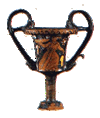
|
Many centuries were necessary to improve the way to purify that rudimentary glass and to find the optimal system for its manufacture. And to settle in the Republic of Venice from the Eastern end of the Mediterranean, the art of glass manufacturing, when Venice got the control of the Mediterranean and its prosperity attracted the experienced Syria glassworkers.
In Venice perhaps initially by security, (there were lots of catastrophic fires caused by the furnaces), but soon to avoid that the industrial secrets were copied, the glass factories were transferred to the Murano island. The craftsmen glassworkers could not leave the island under any pretext, under pain of the confiscation of their possessions and the imprisonment of their relatives. With this drastic system, Venice maintained during several centuries an absolute supremacy in this art. It is not difficult to imagine in such conditions, industrial spying, kidnappings, skirmishes, and thousand histories around that crystal palace-jail. Because the certain thing is that, in spite of the difficulties, many were the Venetian glassworkers who crossed the borders of the republic and went to another places.
|
| |
Those that they were able to flee from the island of Murano established in diverse places that with time have happened to have a certain reputation: Bohemia, Silesia, Moravia, etc. Some of them arrived peculiarly to another island. Ramon Llull, that well-known majorcan, wrote by XIII century XIII about a peculiar and flourishing industry of glass in Majorca. Nowadays still exists the majorcan glass tradition.
|
|
| |
But it's from England (surely taught by some Venetian) where it comes from on the half of century XVIII the manufacture of the bottles as nowadays we know them. Previously, the wine bottle form was like an apple with a very long neck. The new ones cylindrical and with short neck, besides to facilitate their storage and transport, made possible the horizontal position that causes the contact of the liquid with the cork avoiding its drying and so the air intake. It was east type of bottle, with a heavier glass to support 5 or 6 atmospheres of pressure that reaches the wine in his second fermentation, the one that contributed to the success of the discovery of Dom Perignon.
|
| |
The long way needed to bring this knowledge from Hautvillers to Sant Sadurní d'Anoia, and to create the tradition of Cava elaboration on the Penedès lands, in Catalonia, is a story for another day...
|
|
|
|
TIPS FOR CAVA TASTING
- The Cava should be served cold, but not frozen: between 5 and 7 °C.
- The best way to cool the bottle is about four hours before putting it in the refrigerator. If this is not possible, a quick way to cool is immerse it in a bowl with water and ice. It has to maintain this temperature during its tasting.
|
|
- We have to avoid sudden movements when we removed the muzzle. Open the bottle with an inclination of 45 º, by turning the cap slowly.
|
| |
- It is advisable not to take the muzzle to open the bottle, only loosen and place the hand as we open to avoid the cap flying shot.
- The ideal glass is the flute or tulip type, with the end slightly closed to allow the concentration of Cava aromas.
|
|
| |
|
- The glass pot has to be thin and transparent. The advised capacity of the glass is 80 to 100 ml, to avoid degassing and a rapid rise in temperature.
|
- It has to be served in two steps, first leaving the Cava regenerates and foam repose.
|
|
- Fill the glass only two thirds of its capacity, thereby Cava can breathe and we can enjoy its aroma and flavour.
- The glass must be hold by the stem or cane, not by the body, to prevent the Cava warmer.
- Clean the glass pot with no alkaline water, without detergents.
- The Cava must be preserved in a cool and dry place, protected from direct light sources.
|
|
|
